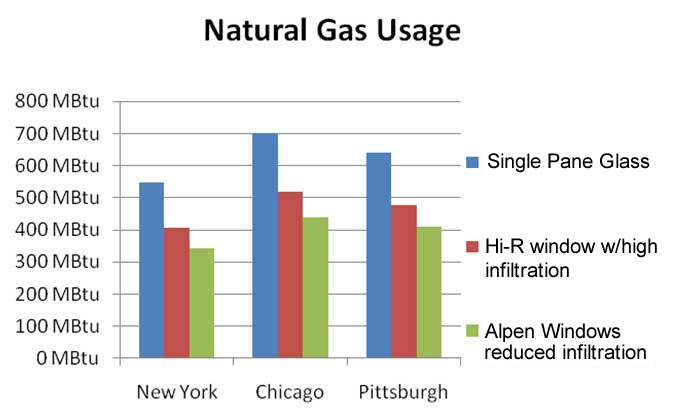Why Air Infiltration Matters for Energy Efficient WindowsWhy Air Infiltration Matters for Energy Efficient Windows
According to ENERGY STAR, air leakage accounts for 25% to 40% of the energy used for heating and cooling in a typical American home.*
What is Air Infiltration?
Air infiltration refers to air leakage through unsealed joints in a structure and around the windows. A leaky home allows unwanted cold air to seap indoors during the winter and warm air in during the summer. The ability of a window to retain heat by reducing air leakage through gaps in or around the window is tested to a national standard and described by its Air Infiltration value and is typically given in cfm/ft² (cubic feet of air per minute/square footage of the window). The lower the Air Infiltration, the less air there is leaking in or out. A common replacement window has an Air Infiltration value of approximately 0.3 cfm/ft2.
What are the Air Infiltration Benefits?
To understand how air infiltration performance affects energy consumption and energy costs, consider the results of the following computer simulation designed to illustrate the impact of air infiltration and R-value on energy consumption in a multi-family home.
A typical multi-family home was modeled with three types of windows. The first model represented the existing energy use of the building with single pane, low R-value, high air infiltration windows. Such windows are common to this building type. The second scenario modeled the same multi-family home with high R-value windows (comparable to Alpen Windows R-value) but without the benefit of improved air infiltration. The third model represented the home with Alpen Windows that feature the combination of both high R-value and low air infiltration. Each home simulation was placed in three cities and focused specifically on heating energy. The graph below depicts the natural gas consumption of each simulation.

High R-value Alpen Windows with superior air infiltration performance can save more energy than other high performance windows.**
As the graph above highlights, R-value and air infiltration both contribute incremental improvements to the overall energy usage. While absolute energy consumption varies somewhat among the cities, the upgrade from single pane, low R-value, high air infiltration windows to high R-value low air infiltration windows created savings in energy consumption across the board.
Note that achieving good air infiltration results depends on window installation in accordance with AAMA guidelines by a certified installer.
What to Look For
When shopping for windows, check the NFRC label to learn about its air infiltration performance. It is important to keep in mind that a window’s air infiltration depends heavily on the window style. The table below summarizes some reference Air Infiltration values for different types of windows.
Air Infiltration Reference Values:
| Window Type | Air Infiltration |
|---|---|
| Common replacement window (based on IECC2006 code requirements) | 0.30 |
| Alpen Windows 525 series Double Hung | 0.16 |
| Alpen Windows 525 series Casement | 0.01 |
When shopping for new or replacement windows, be sure to verify that your new windows have low air infiltration values in order to maximize your energy savings.
**Depending on building type, location, and other factors. Computer simulation used eQuest modeling software. Building model details based on low-rise multi-family residential building and other assumptions.